You are here: Foswiki>Dmi Web>ProjectsOverview>FutureHistoriesRFID (29 Oct 2008, ErikBorra)Edit Attach
Mapping Future Histories of RFID: Workshop Results
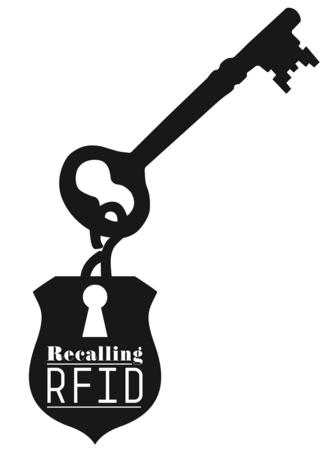
- Recalling RFID
- Workshop Results:
- 1. The Substantive Composition of RFID According to Folksonomy and the Web
- 2. Wikipedia Anonymous Authorship Cartogram: The RFID Entry
- 3. Drama in Search Space: RFID and Arphid Queries Over Time
- 3. RFID Imagery: 'Wet' and 'Dry' Associations Compared
- 4. Issue Packaging on the Web: Style Sheets for RFID Sites by Site Type
Recalling RFID
On 19-20 October 2007, De Balie hosted a two-day event called 'Recalling RFID', a programme by Richard de Boer and Eric Kluitenberg (De Balie), Rob van Kranenburg (Waag Society) and Sabine Niederer (Institute of Network Cultures and Digital Methods Initiative).It's in travel documents, building passes, pet animals, clothing stores, libraries, public pools, theme parks and prisons... and yet only a few of us know what RFID is. RFID (radio frequency identification) uses radio waves to identify people, animals or objects carrying encoded microchips. For government and industry, RFID signifies economic innovation, while for the futurist it marks the next stage in digital connectivity. RFID's pervasiveness will only increase in the years to come, forcing shifts in perceptions of the public sphere and private domain. Alongside the promise RFID brings, there are implications for security, individual privacy and beyond. If it was not already clear, RFID clues us in to the fact that in digital networks, there is no forgetting or memory loss. As such, RFID lends itself both to optimism and fear, forming a microcosm through which a collective, ambivalent relationship to technology is put on display. Recalling RFID centers around this 'invisible' technology with a public seminar, workshops and a smart opera. The program brings together distinctive conceptions of RFID and its uses, reconfiguring discourses as dialogue.The programme consisted of a seminar on October 19, and workshops on October 20, the Digital Methods Initiative organized one of the workshop, dedicated to mapping RFID on the Web. The Mapping Future Histories of RFID workshop was supported by the Mondriaan Foundation Interregeling. Check out Anne Helmond's Recalling RFID photoset on Flickr.

Workshop Results:
The workshop started with a short introductory lecture by Richard Rogers, about researching RFID on the Web. After this, smaller teams were formed that worked on various projects. The day ended with presentations of all the projects.1. The Substantive Composition of RFID According to Folksonomy and the Web
Research Question: Which issue language is significantly associated with RFID according to the top 100 Web pages returned by Google for the query, RFID? Method:Query Google for 'RFID' and uinsert the first 100 results into the Issue Discovery tool, which seeks noun phrases and weighs them according to specificity and frequency. Remove everything that is not 'issue language'. Visualize in a cloud, where terms are scaled resized according to frequency.- Source: google.com;
- Query: RFID
- Tools:Google Scraper, Harvester, Issue Discovery Tool and Tag Cloud Generator
- Date: 20 October 2007
- rfid_compostition_web.pdf
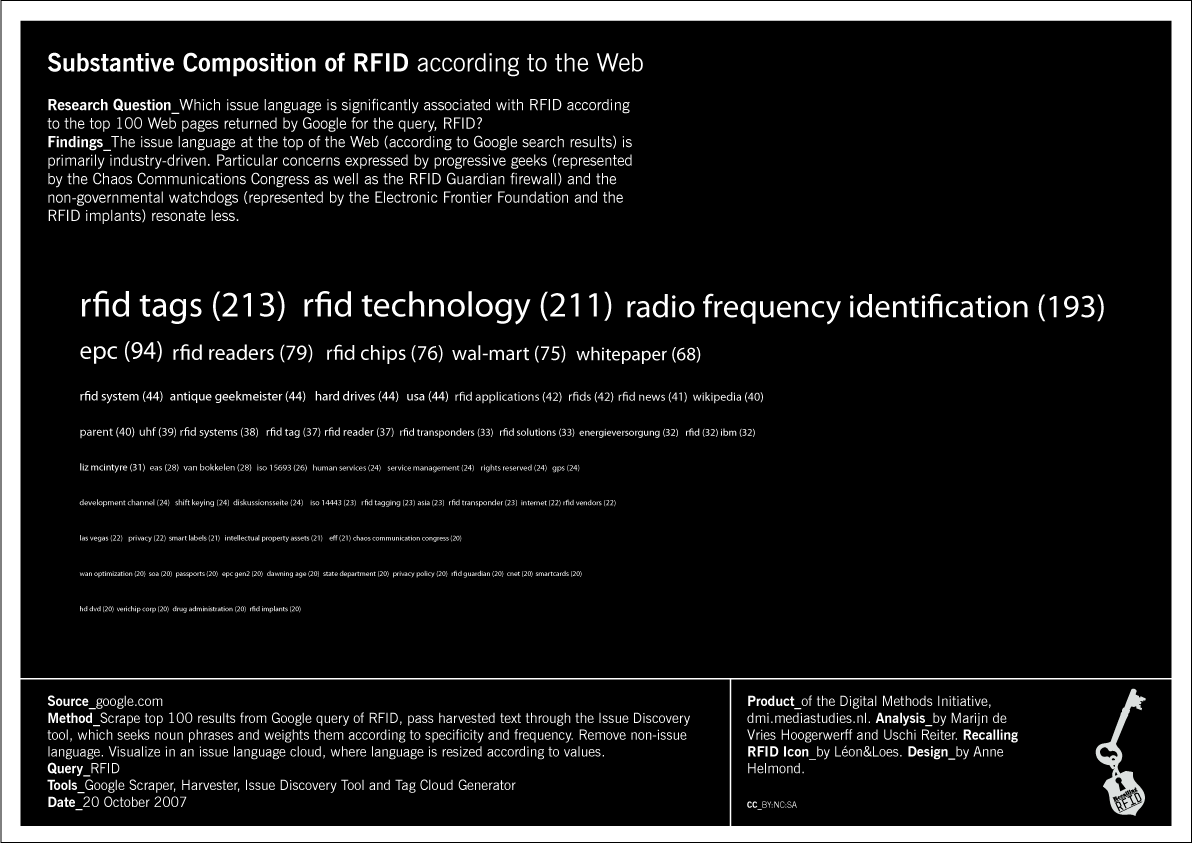 Research Question: Which issue (tag) language is associated with RFID?
Method: Harvest tags related to RFID in del.icio.us. Visualize language, sized by frequency of mentions. Source: del.icio.us; Query: RFID Tools: Google Scraper, Harvester, Issue Discovery Tool and Tag Cloud Generator Date: 20 October 2007
Findings: The folksonomic space shows a commitment to a DIY hacking culture with privacy concerns.
Research Question: Which issue (tag) language is associated with RFID?
Method: Harvest tags related to RFID in del.icio.us. Visualize language, sized by frequency of mentions. Source: del.icio.us; Query: RFID Tools: Google Scraper, Harvester, Issue Discovery Tool and Tag Cloud Generator Date: 20 October 2007
Findings: The folksonomic space shows a commitment to a DIY hacking culture with privacy concerns.
- rfid_compostition_folksonomy.pdf
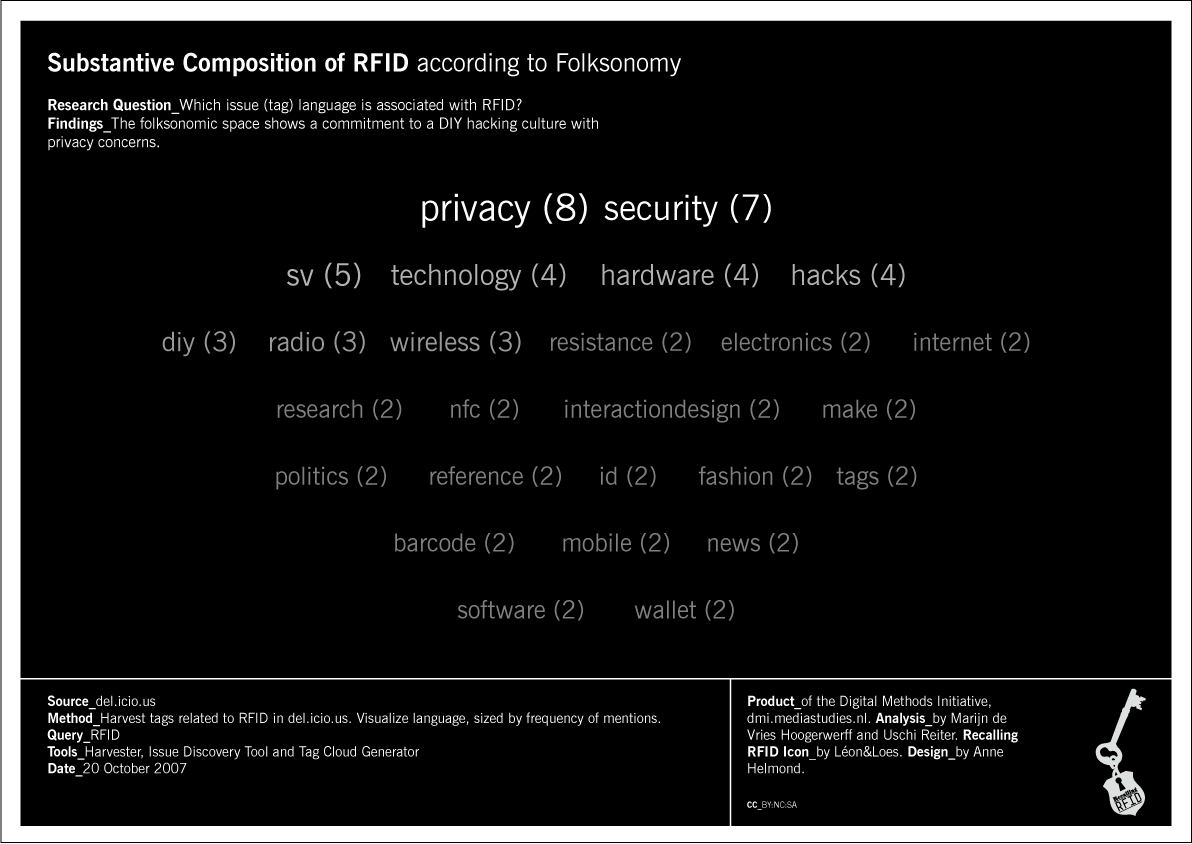
2. Wikipedia Anonymous Authorship Cartogram: The RFID Entry
Question: Where do anonymous Wikipedia edits for RFID originate? Tool: Wikiscanner Findings: As expected, the U.S. dominates the entry, followed by the UK, Australia and Canada. The entry is further edited from Western European countries, as well as India, Taiwan and Indonesia.
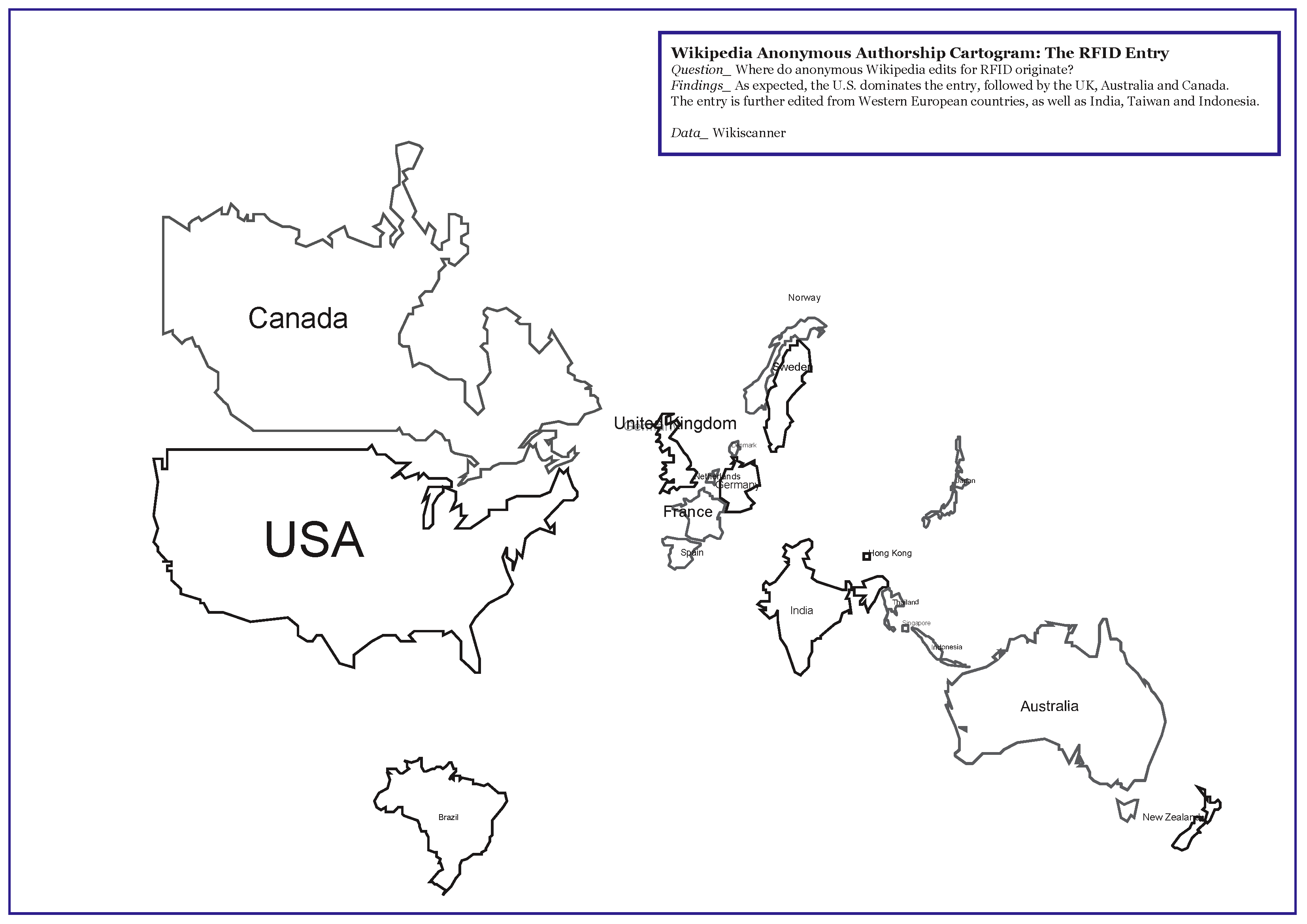
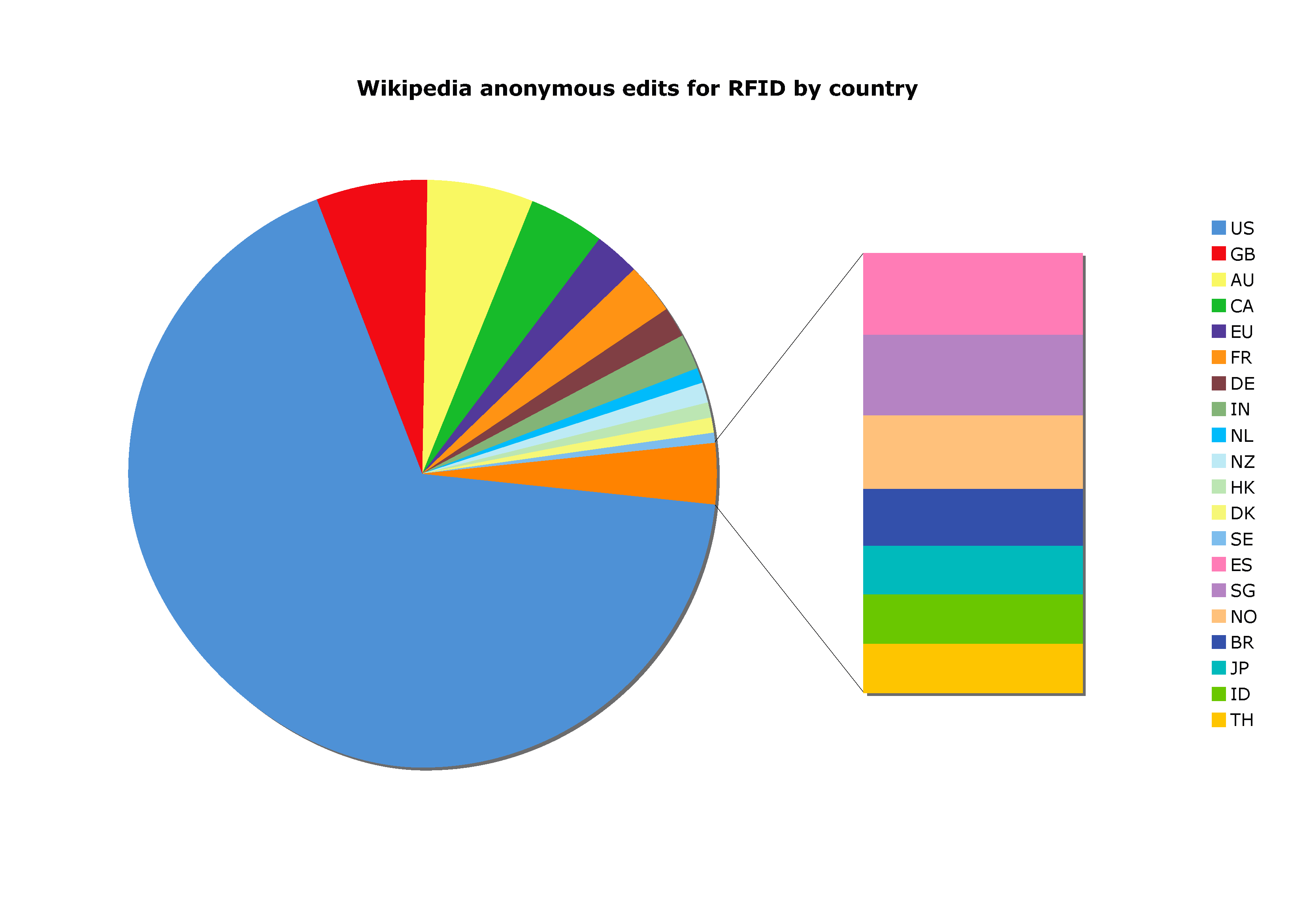
3. Drama in Search Space: RFID and Arphid Queries Over Time
Question: Google is often thought of as a-temporal. A search today and a search tomorrow are not thought of as necessarily authoring vastly different results. Should Google be thought of as a time-sensitive space? Method: Using a data set of query results for RFID and Arphid (the suggested term to be used for art-RFID projects) between May and October 2007, check the ranking of the top twenty results for significant changes. Findings: Certain sites show dramatic ranking changes over the past month.
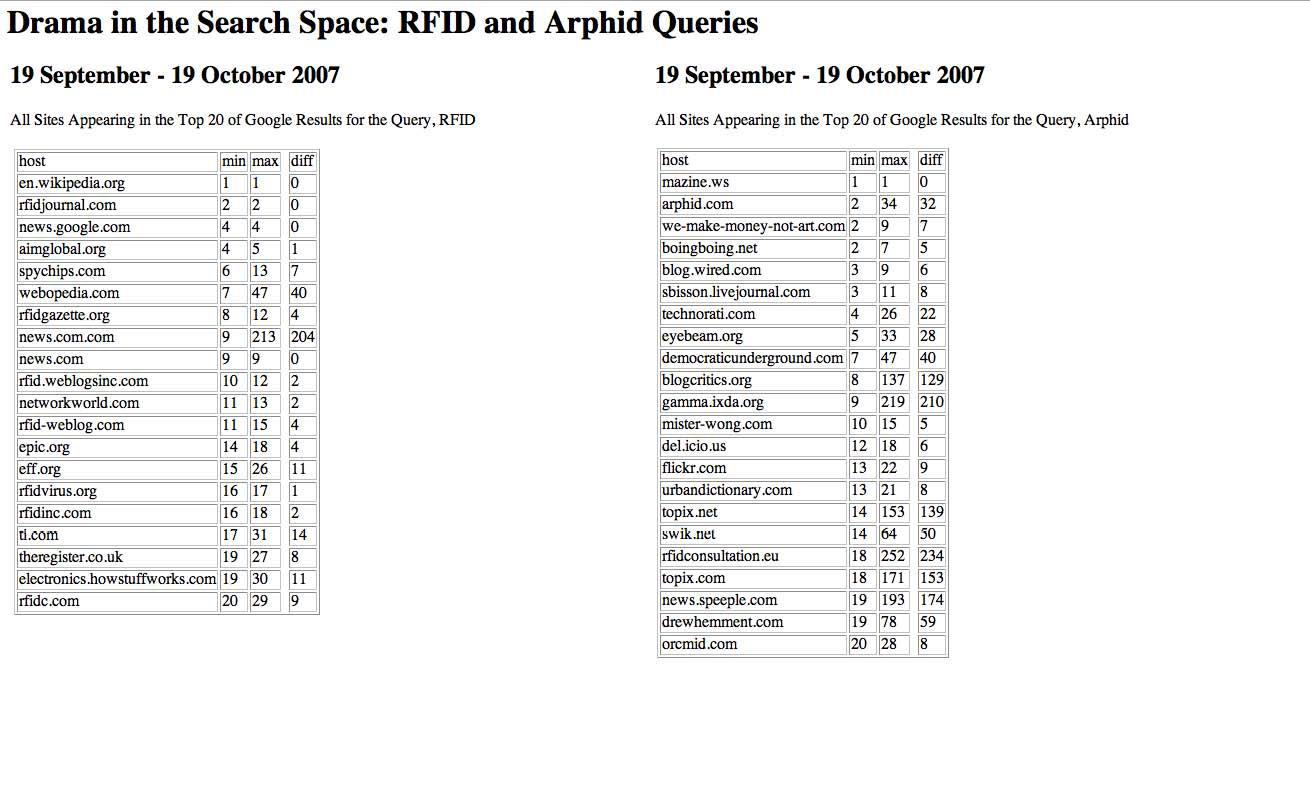
3. RFID Imagery: 'Wet' and 'Dry' Associations Compared
Question: Is RFID in its imagery (according to Google Images) largely associated with technonature or technoculture? Method: Capture the first 100 images of the query "rfid" with the Google Image Scraper. Keep the images in their ranking order and decide which are wet and which are dry, as inspired by Timothy Weaver, University of Denver. Wet means that the images has something to do with people, animals and other living things. Dry means basically the technical things. Timo Arnall provided us with two logos that represent wet and dry, http://www.nearfield.org/2007/10/recalling-rfid.
All the images that represent "wet" are faded (opacity 50%) and have an overlaying wet-icon. This represents the dry imagery. All the images that represent "dry" are faded (opacity 50%) and have an overlaying dry-icon. This represents the wet imagery. Findings:- According to Google Images, the RFID imagery is dry insofar as associations to the biological are limited, e.g., human tagging, animal chip implants, etc.
Associations with machines and machinic diagrams predominate. Eight of the 100 results are wet. - The wet results are however relatively dominant in the top results. The second result in the visualization, which is ordered according to order of appearance in Google Images, is a wet image.
- Three out of the eight wet images are drawings, which is less confronting than a photograph of humans or animals chipped.
- Humans dominate the wet images debate over animals. Five out of eight wet images are human.
- (General question about 'wet' and 'dry' associations was inspired by Timothy Weaver, University of Denver.)

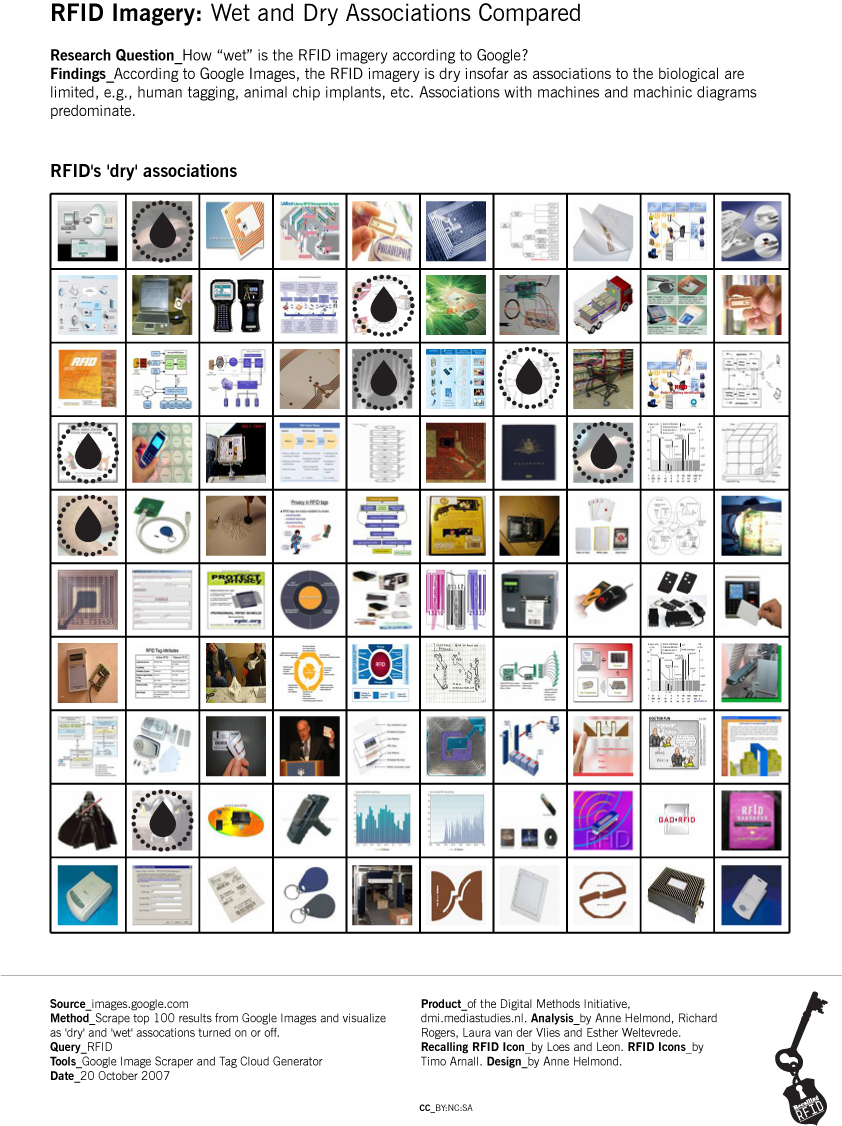
4. Issue Packaging on the Web: Style Sheets for RFID Sites by Site Type
Team: Louise Sikkes, Léon Kranenburg, Sabine Niederer Question: Which colors and styles are implemented on RFID-related Websites? Are there recognizable styles per site type? Method: Capture and analyse the sites in the first 50 results in Google query, RFID. *Google query results for RFID, 20 October 2007:
http://rfid.weblogsinc.com/ http://searchnetworking.techtarget.com/sDefinition/0sid7_gci80598700.html http://w2.eff.org/Privacy/RFID/ http://www.aimglobal.org/technologies/rfid/ http://www.epic.org/privacy/rfid/ http://www.networkworld.com/topics/rfid.html http://www.news.com/2010-1069-980325.html http://www.privcom.gc.ca/fs-fi/02_05_d_28_e.asp http://www.rfid-weblog.com/ http://www.rfid.fi/template_rfid.asp%3Flang%3D3%26s%3D433%26sua%3D5%26source%3Dadwords http://www.rfidgazette.org/ http://www.rfidinc.com/ http://www.rfidjournal.com/ http://www.rfidjournal.com/article/view/1339/1/129 http://www.rfidjournal.com/faq http://www.rfidvirus.org/ http://www.spychips.com/ http://www.spychips.com/what-is-rfid.html http://www.symbol.com/products/rfid-readers http://www.technovelgy.com/ct/Technology-Article.asp?ArtNum=1 http://www.theregister.co.uk/2003/06/27/rfid_chips_are_here/ http://www.ti.com/rfid/shtml/rfid.shtml http://www.webopedia.com/TERM/R/RFID.html http://csrc.nist.gov/publications/nistpubs/800-98/SP800-98_RFID-2007.pdf http://ec.europa.eu/information_society/policy/rfid/ http://electronics.howstuffworks.com/smart-label.htm http://hardware.silicon.com/storage/0390246493912004000.htm http://networks.silicon.com/lans/0390246633916444600.htm http://rfid.wowgao.com/ http://rfidprivacy.mit.edu/access/what.html http://science.slashdot.org/article.pl?sid=07/09/08/1832243 http://ubiks.net/local/blog/jmt/stuff3/ http://www.abiresearch.com/products/service/RFID_Research_Service http://www.aimglobal.org/technologies/rfid/what_is_rfid.asp http://www.alliancegroup.co.uk/rfid.htm http://www.biblio-tech.com/html/rfid.html http://www.canadianrfidcentre.ca/ http://www.cnn.com/2006/TECH/07/10/rfid/index.html http://www.eff.org/issues/rfid http://www.electrocom.com.au/rfid.htm http://www.engadget.com/tag/rfid * Take screenshots * Use eyedropper to capture colors * Group by dominant colours Findings: See graphic. There are design elements that vary per sector, for instance in the highlighted trade/trade press sector there's a lot of red combined with dark blue / dark green, in a 3 columns layout.There's also certain trends in the industry, with yellow/orange and bright blue web design.- issue_packaging.jpg:
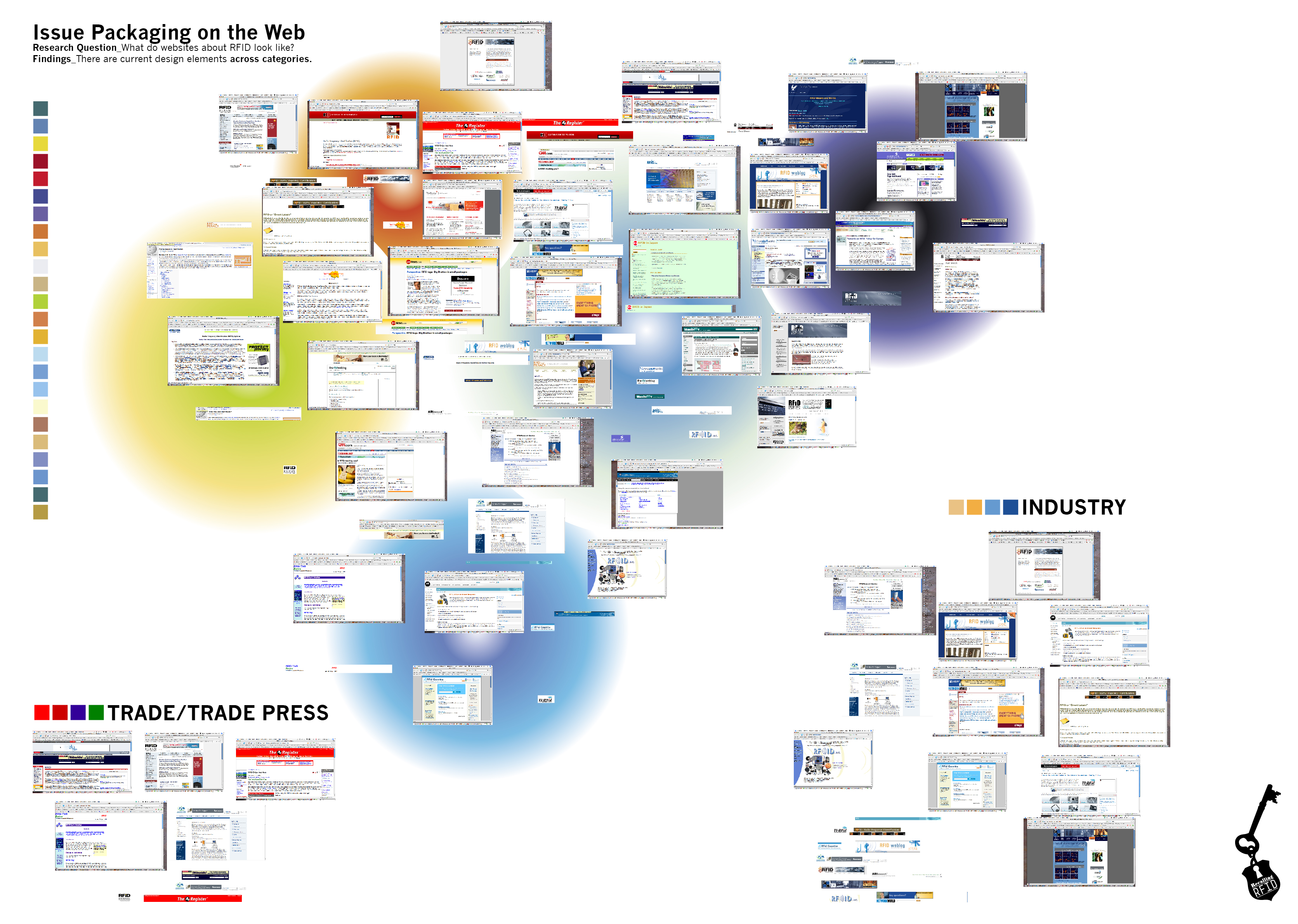
- According to Google Images, the RFID imagery is dry insofar as associations to the biological are limited, e.g., human tagging, animal chip implants, etc.
- rfid_compostition_folksonomy.pdf
| I | Attachment | Action | Size | Date | Who | Comment |
|---|---|---|---|---|---|---|
| |
drama_rfid.pdf | manage | 119 K | 23 Oct 2007 - 21:33 | RichardRogers | |
| |
drama_rfid.png | manage | 450 K | 23 Oct 2007 - 21:32 | RichardRogers | |
| |
issue_packaging.jpg | manage | 3 MB | 20 Oct 2007 - 15:32 | SabineNiederer | |
| |
logo_ms.gif | manage | 3 K | 12 Sep 2008 - 09:49 | Main.issuecrawler14 | |
| |
rfid-logo-def.jpeg | manage | 9 K | 12 Sep 2008 - 09:36 | Main.issuecrawler14 | |
| |
rfid_compostition_folksonom.png | manage | 65 K | 24 Oct 2007 - 11:25 | UnknownUser | |
| |
rfid_compostition_folksonomy.pdf | manage | 369 K | 24 Oct 2007 - 11:31 | UnknownUser | |
| |
rfid_compostition_web.pdf | manage | 353 K | 24 Oct 2007 - 11:37 | UnknownUser | |
| |
rfid_compostition_web.png | manage | 85 K | 24 Oct 2007 - 11:26 | UnknownUser | |
| |
rfid_imagery_dry.pdf | manage | 1 MB | 23 Nov 2007 - 21:24 | RichardRogers | Recalling RFID workshop - Image Analysis - Final 'dry' association |
| |
rfid_imagery_dry.png | manage | 660 K | 23 Oct 2007 - 17:44 | EstherWeltevrede | Visualization Recalling RFID dry |
| |
rfid_imagery_dry_corrected.jpg | manage | 550 K | 21 Oct 2008 - 16:23 | RichardRogers | Recalling RFID workshop - image analysis - 'dry' corrected jpg |
| |
rfid_imagery_dry_corrected.pdf | manage | 2 MB | 21 Oct 2008 - 16:18 | RichardRogers | Recalling RFID workshop - image analysis - 'dry' corrected |
| |
rfid_imagery_wet.pdf | manage | 1 MB | 23 Nov 2007 - 17:14 | EstherWeltevrede | rfid imagery wet |
| |
rfid_imagery_wet.png | manage | 669 K | 23 Oct 2007 - 17:44 | EstherWeltevrede | Visualization Recalling RFID wet |
| |
rfid_imagery_wet_corrected.jpg | manage | 587 K | 21 Oct 2008 - 16:25 | RichardRogers | Recalling RFID workshop - image analysis - 'wet' corrected jpg |
| |
rfid_imagery_wet_corrected.pdf | manage | 3 MB | 21 Oct 2008 - 16:20 | RichardRogers | Recalling RFID workshop - image analysis - 'wet' corrected |
| |
wikipedia_rfid.pdf | manage | 695 K | 23 Oct 2007 - 21:20 | RichardRogers | Recalling RFID workshop - Wikipedia Entry for RFID |
| |
wikipedia_rfid_entry_piechart.pdf | manage | 215 K | 23 Oct 2007 - 21:34 | RichardRogers | |
| |
wikipedia_rfid_entry_piechart.png | manage | 59 K | 23 Oct 2007 - 21:32 | RichardRogers | |
| |
wikipedia_rfidentry_cartogram.pdf | manage | 484 K | 23 Oct 2007 - 21:34 | RichardRogers | |
| |
wikipedia_rfidentry_cartogram.png | manage | 90 K | 23 Oct 2007 - 21:33 | RichardRogers |
Edit | Attach | Print version | History: r30 < r29 < r28 < r27 | Backlinks | View wiki text | Edit wiki text | More topic actions
Topic revision: r30 - 29 Oct 2008, ErikBorra
 Copyright © by the contributing authors. All material on this collaboration platform is the property of the contributing authors.
Copyright © by the contributing authors. All material on this collaboration platform is the property of the contributing authors. Ideas, requests, problems regarding Foswiki? Send feedback


